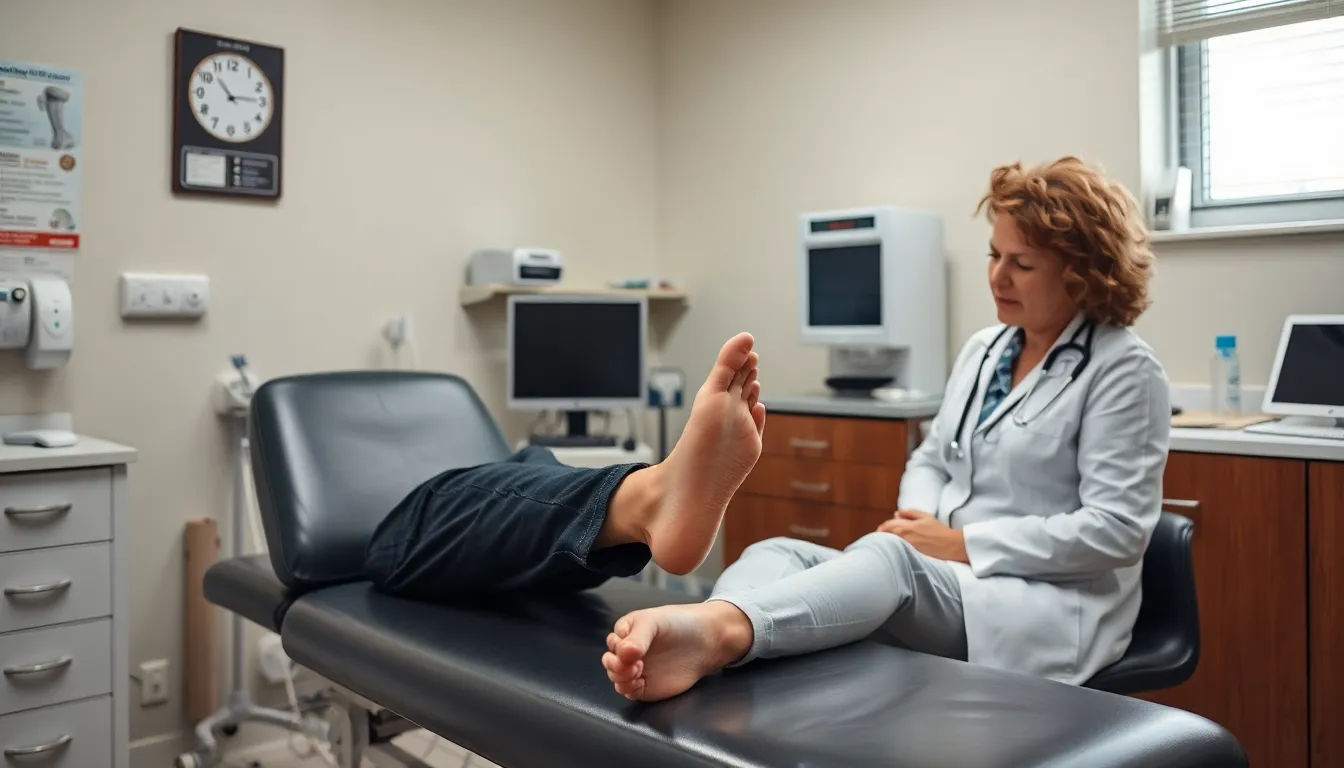Ever felt like your foot’s staging a protest every time you take a step? If the top of your foot is throwing a tantrum while you walk, you’re not alone. This pesky pain can turn a simple stroll into an Olympic event. Whether you’re dodging that pesky toe cramp or dealing with a full-on foot rebellion, understanding the cause is the first step toward relief.
Table of Contents
ToggleUnderstanding Top of Foot Pain When Walking
Top of foot pain significantly impacts mobility. Identifying the causes and associated risk factors aids in managing this discomfort effectively.
Common Causes of Discomfort
Stress fractures often cause pain on the top of the foot. These small cracks appear due to repetitive stress and overuse, impacting athletes and active individuals. Tendonitis can also result in discomfort; the inflammation of tendons in this area creates tenderness. Additionally, conditions such as arthritis lead to joint pain that affects the top of the foot. Other factors include ill-fitting shoes that place excess pressure on the foot’s structure. Proper footwear alleviates unnecessary strain, reducing the onset of pain.
Risk Factors Associated with Foot Pain
Age represents a significant risk factor for top of foot pain. As people age, natural wear and tear occurs in joints and tendons, leading to discomfort. High-impact activities also contribute to the likelihood of developing these issues. Individuals engaging in sports or exercises that require excessive foot movement often face a higher risk. Obesity places additional weight on the feet, increasing pressure and discomfort during walking. Genetics can influence predisposition to certain foot conditions, making awareness crucial for proactive management.
Symptoms and Diagnosis

Top of foot pain often presents with various symptoms that can indicate specific underlying conditions. Recognizing these symptoms is crucial for effective management.
Identifying Pain Symptoms
Common symptoms include sharp, aching, or throbbing sensations on the top of the foot. Patients may also experience swelling or tenderness in the affected area. Difficulty when walking or putting weight on the foot often accompanies these symptoms. Numbness or tingling signals nerve involvement, while redness may suggest inflammation. Identifying these signs helps in understanding the severity and potential cause of the discomfort.
Diagnostic Methods for Foot Pain
Healthcare providers typically utilize several methods for diagnosing top of foot pain. Physical examinations assess pain location and range of motion. Imaging techniques, such as X-rays or MRIs, help visualize fractures, tendon injuries, and other structural issues. Blood tests may identify signs of inflammation or arthritis. Patients often undergo functional assessments to evaluate stability, strength, and gait patterns, providing a comprehensive understanding of their condition.
Treatment Options
Several effective treatment options exist for managing pain on the top of the foot. Both home remedies and professional medical treatments can provide relief and promote healing.
Home Remedies for Relief
Resting the affected foot often alleviates discomfort. Applying ice for 15 to 20 minutes several times a day reduces swelling and inflammation. Elevating the foot helps decrease pressure and pain. Over-the-counter pain relievers, such as ibuprofen or acetaminophen, can manage pain effectively. Wearing supportive footwear that provides adequate cushioning is critical for comfort. Additionally, gentle stretching and strengthening exercises may improve flexibility and reduce future risk of injury.
Professional Medical Treatments
Consultation with a healthcare provider usually proves beneficial for persistent pain. Physical therapy often includes targeted exercises to enhance strength and mobility. Corticosteroid injections may reduce inflammation in painful areas. In cases of severe injury, surgical intervention could be necessary. Imaging tests like X-rays or MRIs help clinicians assess serious issues, ensuring accurate treatment plans. Custom orthotics may provide additional support and alignment corrections to alleviate foot pain, optimizing overall function.
Preventive Measures
Preventive measures can significantly reduce the risk of top of foot pain during walking. Individuals can take strategic steps for enhanced foot health.
Footwear Choices and Support
Choosing the right footwear is crucial for preventing top of foot pain. Properly fitting shoes offer essential support and cushioning. Avoiding narrow or high-heeled shoes decreases the risk of discomfort. Look for shoes with a wide toe box that allows maximum space for foot movement. Using orthotic inserts can provide additional arch support and help align the foot properly. Sturdy running or walking shoes designed for specific activities can enhance comfort and stability. Maintaining a habit of replacing worn-out shoes ensures continued foot support.
Stretching and Strengthening Exercises
Incorporating stretching and strengthening exercises can improve foot flexibility and strength. Stretching the calf muscles can relieve tension in the foot and ankle, lessening pain risk. Engaging in toe curls and ankle rotations enhances the muscles responsible for foot stability. Strength-building exercises, such as resistance band workouts, specifically target foot and lower leg muscles. Regularly practicing these routines promotes better balance and coordination. Prioritizing consistent exercises contributes to overall foot health and reduces discomfort during walking.
Top of foot pain can significantly hinder daily activities and overall quality of life. Understanding its causes and recognizing symptoms play a vital role in effective management. By taking proactive steps such as choosing appropriate footwear and engaging in strengthening exercises, individuals can reduce their risk of experiencing this discomfort. When pain persists, seeking professional guidance ensures a tailored approach to treatment. Prioritizing foot health not only alleviates pain but also enhances mobility and well-being. With the right strategies in place, it’s possible to walk comfortably and confidently once again.


